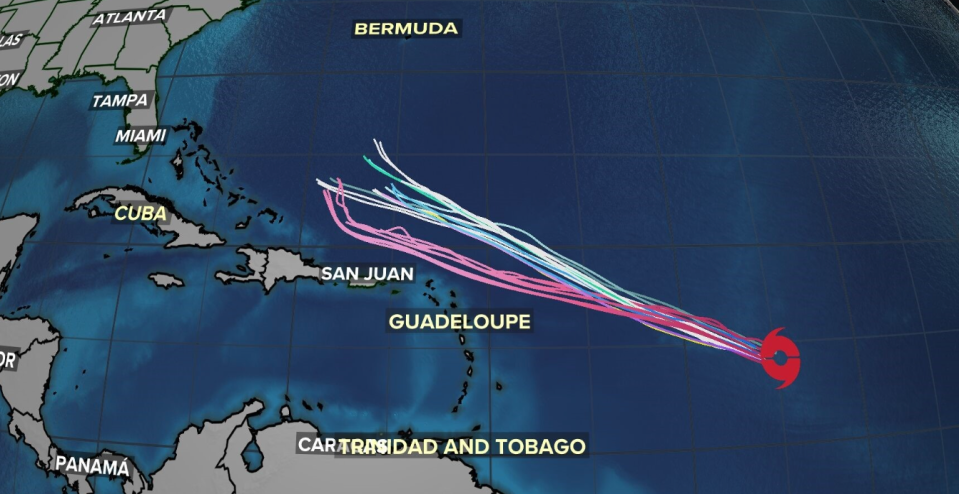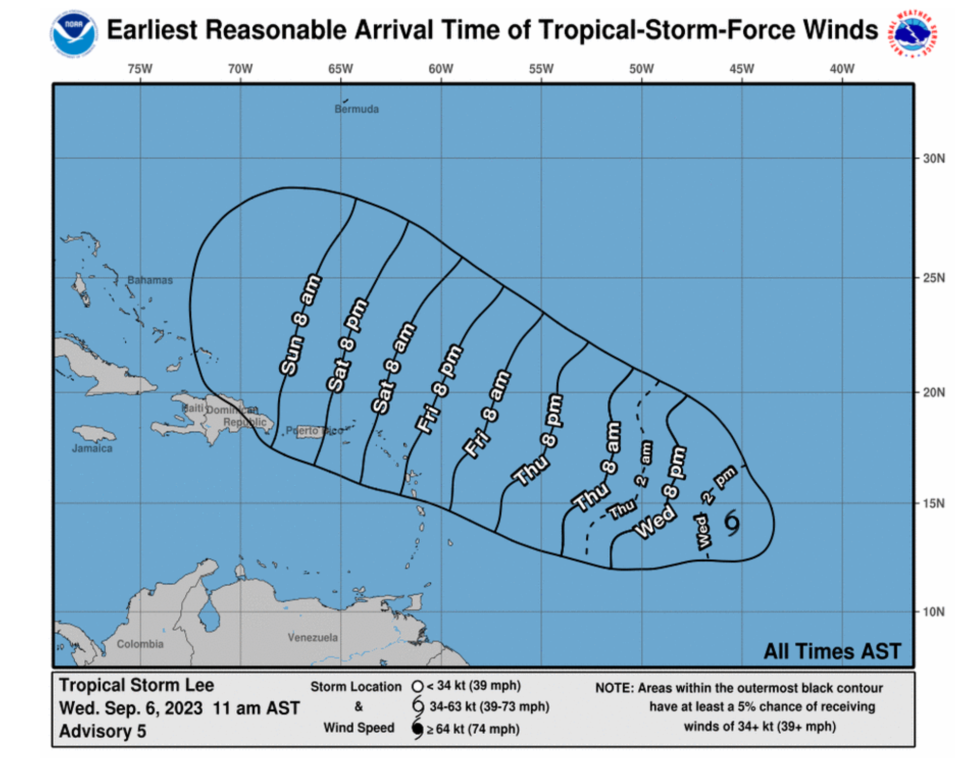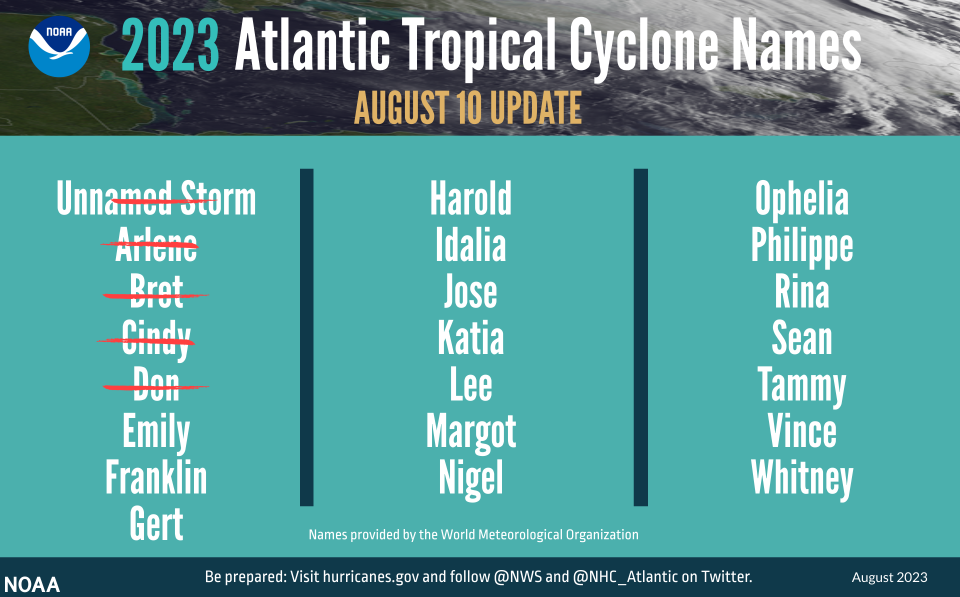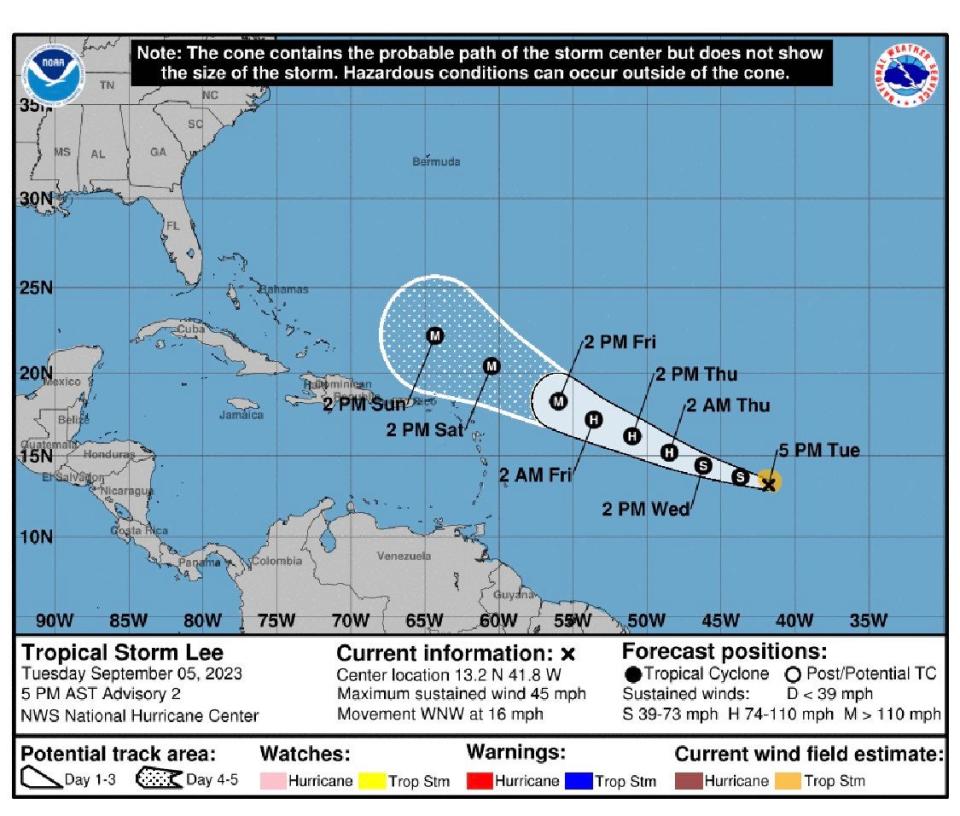Storm Lee strengthens to hurricane and is expected to become ‘extremely dangerous’ by Saturday: Live
- Oops!Something went wrong.Please try again later.
Tropical Storm Lee strengthened to a hurricane on Wednesday afternoon and is expected to build into an “extremely dangerous” storm by early Saturday, forecasters warned.
Hurricane Lee is about 1130 miles (1815km) east of the northern Leeward Islands, according to the 5pm (eastern time) report from the National Hurricane Center, with maximum sustained winds of 75 miles per hour (120 kph).
Current projections show Hurricane Lee will not make landfall but pass north of the British Virgin Islands, which is still recovering from hurricanes Maria and Irma in September 2017.
Lee is the 12th named storm of the Atlantic hurricane season, which runs from June 1 to November 30.
In the Pacific, Jova strengthened into a Category 2 hurricane far off the southwest coast of Mexico and posed no threat to land. It was located some 600 miles south of Baja California and moving west-northwest at 13 mph with winds up to 105mph. It was expected to become a major hurricane by Wednesday night.
Key Points
Tropical storm Lee could become Category 5 'extremely dangerous' storm
Path of Tropical storm Lee: Where is the storm currently and where will it head?
Will Tropical storm Lee make landfall in the Caribbean or the US?
Breaking: Storm Lee strengthens to a hurricane
22:21 , Louise Boyle
Tropical Storm Lee strengthened to a hurricane on Wednesday afternoon and is expected to build into an “extremely dangerous” storm by early Saturday, forecasters warned.
Hurricane Lee is about 1130 miles (1815km) east of the northern Leeward Islands, according to the 5pm (eastern time) report from the National Hurricane Center, with maximum sustained winds of 75 miles per hour (120 kph).
Current projections show Hurricane Lee will not make landfall but pass north of the British Virgin Islands, which is still recovering from hurricanes Maria and Irma in September 2017.
Lee is the 12th named storm of the Atlantic hurricane season, which runs from June 1 to November 30.
What are the major hurricane hazards?
22:02 , Louise Boyle
The main hazards from tropical cyclones - the catch-all term for tropical depressions, tropical storms, and hurricanes - are storm surge flooding, inland flooding from heavy rains, destructive winds, tornadoes, and high surf and rip currents, according to the National Weather Service.
- Storm surge can travel several miles inland, especially along bays, rivers, and estuaries.
- Flooding from heavy rains is the second leading cause of fatalities from landfalling tropical cyclones. Widespread torrential rains associated with these storms often cause flooding hundreds of miles inland. This flooding can persist for several days after a storm has dissipated.
- Winds from a hurricane can destroy buildings and manufactured homes. Signs, roofing material, and other items left outside can become flying missiles during hurricanes.
- Tornadoes can accompany landfalling tropical cyclones. These tornadoes typically occur in rain bands well away from the center of the storm.
- Dangerous waves produced by a tropical cyclone’s strong winds can pose a significant hazard to coastal residents and mariners. These waves can cause deadly rip currents, significant beach erosion, and damage to structures along the coastline, even when the storm is more than a 1,000 miles offshore.
National Weather Service
Watch: Lee could become Cat 5 hurricane soon
21:35 , Louise Boyle
Tropical Storm Lee: What are spaghetti models?
21:01 , Louise Boyle
Spaghetti models get their name from how they look - a jumble of squiggly lines.
In fact, what looks like hurried drawings are actually computer models tracking the potential paths of a tropical storm or hurricane.
The more that the “spaghetti strands” lie close together or overlap, means the greater the confidence in the forecast. Further apart lines indicate more uncertainty.

‘Life-threatening surf and rip currents'
19:44 , Louise Boyle
The National Hurricane Center warned of “life-threatening surf and rip currents” across portions of the Lesser Antilles later this week as Tropical Storm Lee grows into a major hurricane.
11AM AST Sep 6: #Lee is forecast to become a major hurricane by early Saturday. Swells are likely to cause life-threatening surf and rip currents across portions of the Lesser Antilles late this week. Stay up to date with the latest at https://t.co/tW4KeGdBFb pic.twitter.com/2CVr855fan
— National Hurricane Center (@NHC_Atlantic) September 6, 2023
Watch: Satellite footage shows Storm Lee as weather system expected to become hurricane
19:10 , Louise Boyle
FEMA issues warning over Tropical Storm Lee
18:39 , Louise Boyle
The US Federal Emergency Management Agency (FEMA) issued a warning on Tropical Storm Lee on Wednesday as it looked set to become a major hurricane by the weekend.
“Make sure you have different ways to receive weather alerts and prepare in advance if it’ll affect your area,” FEMA said.
Tropical Storm #Lee could become a major hurricane by this weekend. Make sure you have different ways to receive weather alerts and prepare in advance if it’ll affect your area.
Preparedness tips: https://t.co/rfjUqvcppP https://t.co/sbnhc30UNq pic.twitter.com/C4yJJwFPLN— FEMA (@fema) September 6, 2023
How Tropical Storm Lee looks from space
18:10 , Louise Boyle
Tropical Storm Lee was captured from space on Wednesday.
The vast system was seen moving through the Caribbean in imagery shared by the Cooperative Institute for Research in the Atmosphere (CIRA) at Colorado State University. Lee is expected to gain hurricane status later today.
This morning's view of Tropical Storm Lee.
Lee nears hurricane status, likely becoming one later today. pic.twitter.com/26OS7Jm6Pk— CIRA (@CIRA_CSU) September 6, 2023
Billion-dollar losses from Hurricane Idalia
17:40 , Louise Boyle
The total private market insured losses from Hurricane Idalia, which struck Florida as a Category 3 storm last week, have been estimated between $3-$5 billion by Moody’s Analytics.
The risk modeling firm put the best estimate at $3.5bn for the insured losses associated with Idalia’s winds, storm surge, and flooding caused by heavy rains.
On top of this, Moody’s estimated around $500 million in losses to the National Flood Insurance Program - the US government initiative which provides affordable insurance to property owners.
Arrival times of tropical storm-force winds
17:11 , Louise Boyle

Hurricane Jova develops in Pacific
16:38 , Louise Boyle
In the Pacific Ocean, Jova strengthened into a Category 2 hurricane far off the southwest coast of Mexico and posed no threat to land.
It was located some 600 miles south of Baja California and moving west-northwest at 13 mph with winds up to 105mph.
It was expected to become a major hurricane by Wednesday night.
The Associated Press
Earth experienced hottest summer on record in 2023, UN says
16:00 , Louise Boyle
The sweltering summer of 2023 has been officially confirmed as the hottest summer on record for the northern hemisphere by the United Nations.
This August was found to be about 1.5 degrees Celsius (2.7 degrees Fahrenheit) hotter than pre-industrial times, scientists from the UN agency, the World Meteorological Organisation (WMO), and the European climate service, Copernicus, announced on Wednesday.
The record-breaking August is also the second hottest month ever after this July, WMO said.
August marked the end of a brutal summer in the northern hemisphere with land and ocean heat records shattered across continents; extreme heatwaves and deadly wildfires.
Hotter ocean temperatures are also fuelling stronger hurricanes in the Atlantic, scientists say.
Stuti Mishra reports

Earth experienced ‘hottest summer on record’ in 2023, UN says
Watch: US and Caribbean on alert for growing tropical system
15:31 , Louise Boyle
What is the path of Tropical Storm Lee?
15:00 , Louise Boyle
Tropical Storm Lee churned through the open waters of the Atlantic on Wednesday and was expected to soon become a hurricane as it approached the Caribbean.
The storm was located about 1,265 miles (2,040 kilometers) east-southeast of the northern Leeward Islands. It had maximum sustained winds of 65 mph (100 kph) and was moving west-northwest at 14 mph (22 kph), according to the National Hurricane Center.
It was not forecast to make landfall, but it is projected to pass just northeast of the British Virgin Islands, which is still recovering from hurricanes Maria and Irma that hit in September 2017.
The Associated Press
Storm Lee makes a dozen
14:33 , Louise Boyle
Tropical Storm Lee is the 12th named storm to form in the Atlantic Ocean in 2023.
The Atlantic hurricane season, which runs from 1 June to 30 November, is forecast to be above average this year. Late August and early September are typically the season’s peak.

Watch: Hurricane Lee nears hurricane strength
14:08 , Louise Boyle
Tropical Storm Lee is approaching hurricane strength
13:52 , Louise Boyle
The 5am (eastern time) report from the National Hurricane Center notes that Lee is “approaching hurricane strength”.
Path of Tropical storm Lee: Where is the storm currently and where will it head?
12:15 , Stuti Mishra
Tropical storm Lee was located some 1,230 miles (1,980km) east of the Lesser Antilles a few hours ago with maximum sustained winds of 50mph (85kph).
The projected path of the tropical storm, according to NHC, shows it was moving west-northwest at 16mph (26kph) and could reach the Caribbean by this weekend.

Tropical Storm Lee 'approaching hurricane strength', says NHC
11:15 , Stuti Mishra
Tropical Storm Lee is soon “approaching hurricane strength” before it further intensifies and becomes an “extremely dangerous” Category 5 hurricane by this weekend, according to the latest update from National Hurricane Center.
Tropical Storm #Lee Advisory 4: Lee Approaching Hurricane Strength. Expected to Rapidly Intensify Into an Extremely Dangerous Hurricane By the Weekend. https://t.co/tW4KeGe9uJ
— National Hurricane Center (@NHC_Atlantic) September 6, 2023
Hurricanes are getting stronger. Here’s why
10:15 , Stuti Mishra

Hurricanes are getting stronger. Here’s why
'This isn't good': Tropical Storm Lee forecast to move more 'westerly and southerly',
09:33 , Stuti Mishra
New projections are showing that Tropical Storm Lee could take a more "westerly and southerly" route than predicted previously, which means slightly increased chances of the storm heading closer to the Caribbean.
Earlier the storm, which could intensify to Category 5, was forecast to turn northwards.
Eric Feigl-Ding, an epidemiologist and health economist said this change is "worrisome".
"This isn’t good—not only is there worries by some that Hurricane #Lee might become a Category 5 storm, but models are now showing a much more westerly and southerly than before (earlier models said would head more north). This is worrisome," he wrote on X, previously known as Twitter.
🌀This isn’t good—not only is there worries by some that Hurricane #Lee might become a Category 5 storm, but models are now showing a much more westerly and southerly than before (earlier models said would head more north). This is worrisome.pic.twitter.com/UEZemm9rFx
— Eric Feigl-Ding (@DrEricDing) September 6, 2023
Leeward Islands could be first to be impacted by Tropical Storm Lee
09:00 , Stuti Mishra
Tropical Storm Lee "could bring impacts to the Leeward Islands", the National Hurricane Center has warned, urging residents to keep an eye on updates.
"It is becoming a question of when and not if rapid intensification occurs with Lee," the advisory noted. Winds are forecast to reach 145 mph which is a powerful Category 4 "major hurricane."
'While it is too soon to determine the location and magnitude of these possible impacts, interests in this area should monitor the progress of the depression and updates to the forecast," the NHC said.
Tropical Depression Thirteen - forecast to become Tropical Storm Lee later today - is also forecast to become a major hurricane by this weekend and could bring impacts to the Leeward Islands by that time. While it is too soon to determine the location and magnitude of these… pic.twitter.com/5rP5ZNvxfc
— National Weather Service (@NWS) September 5, 2023
Satellite footage shows how Lee intensified into a storm
08:31 , Stuti Mishra
This is Tropical Storm #Lee.
A magnificent example of how a tropical wave from the western coast of Africa can develop into a tropical storm in just 5 days. pic.twitter.com/qfuTqj75W2— Zoom Earth (@zoom_earth) September 5, 2023
Another storm brews in the Pacific
08:00 , Stuti Mishra
As tropical storm Lee is set to intensify in the Atlanic, in the Pacific, tropical storm Jova is continuing to strengthen well off the southwest coast of Mexico, but posed no threat to land yet.
Jova had 70mph (110kmh) winds and was forecast to become a hurricane today, according to the National Hurricane Center. It was about 675 miles (1,085kms) south of the southern tip of Baja California and moving west-northwest at 9mph (15kph).
How extreme ocean temperatures have made this hurricane season more dangerous?
07:30 , Stuti Mishra
Tropical storm Lee is churning in the Atlantic, once again threatening the Caribbean and the US southeast coast, less than a week after Florida was battered by Category 3 Hurricane Idalia.
The remnants of Idalia, and another hurricane, Franklin, were causing strong ocean rip currents along the mid-Atlantic coast with at least eight deaths reported over the Labor Day holiday weekend.
The Atlantic hurricane season, which runs from 1 June to 30 November, is forecast to be above average this year.
Between 14 to 21 named storms are forecast. Of those, six to 11 could become hurricanes, with two to five of them possibly becoming major hurricanes. Late August and early September are typically the season’s peak.
Ocean temperatures have hit historic highs this summer. Warming oceans fuel stronger tropical cyclones that bring more heavy rainfall and higher storm surge when they make landfall, according to Climate Central.
Will Tropical storm Lee make landfall in the Caribbean or the US?
07:10 , Stuti Mishra
Preliminary forecasts are not predicting any landfall, although the centre warned that “it is too early to determine exactly how close this system will be to the Leeward Islands.”
Tropical storm Lee could become Category 5 'extremely dangerous' storm
06:50 , Stuti Mishra
Tropical storm Lee is forecast to strengthen into an "extremely dangerous" hurricane by Friday as it moves over very warm waters and pass just northeast of the Caribbean region, the centre said.
Meteorologist Ryan Maue suggested on X, formerly Twitter, that Lee could become a “monstrous storm” in the Category 4 or 5 range but travel “safely north” of the Leeward Islands and Puerto Rico.
Colin McCarthy, whose Twitter account US Stormwatch follows extreme weather globally, also wrote “the storm could reach historically strong levels” as it moves through “Atlantic waters still at record hot levels.”
Tropical Storm #Lee will likely become the first Category 5 hurricane in the Atlantic in 2023 this weekend as it explosively intensifies.
Some hurricane models suggest the storm could reach historically strong levels (170+ mph) as it moves through a low wind shear environment… pic.twitter.com/Kip1XZkkwb— Colin McCarthy (@US_Stormwatch) September 6, 2023
Path of Tropical storm Lee: Where is the storm currently and where will it head?
06:31 , Stuti Mishra
Tropical storm Lee was located some 1,230 miles (1,980km) east of the Lesser Antilles a few hours ago with maximum sustained winds of 50mph (85kph).
The projected path of the tropical storm, according to NHC, shows it was moving west-northwest at 16mph (26kph) and could reach the Caribbean by this weekend.

06:13 , Stuti Mishra
Tropical Storm Lee was announced by the National Hurricane Center (NHC) at 5pm (eastern time) on Tuesday.
It is expected to intensify into an “extremely dangerous” hurricane by the weekend. Read more:

Tropical Storm Lee expected to become ‘extremely dangerous’ hurricane by weekend
05:58 , Stuti Mishra
Welcome to The Independent’s live blog on tropical storm Lee churning in the Atlantic Ocean, Stay tuned for the latest forecasts and updates.

